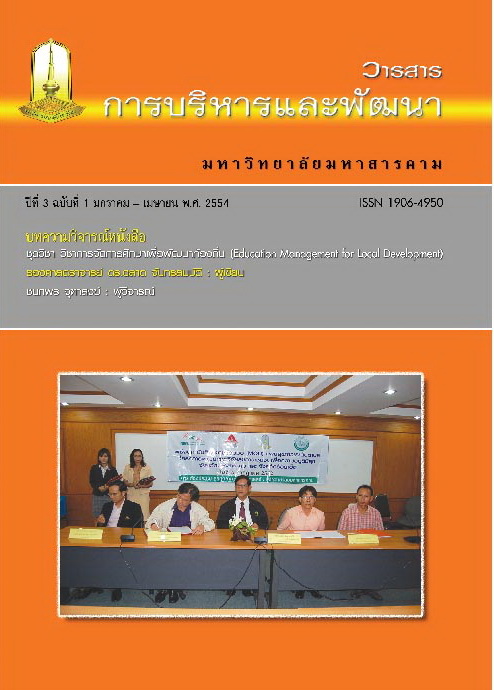ข้อเสนอเพื่อการบริหารจัดการสถานศึกษาสู่ความเป็นเลิศตามนโยบาย ของสำนักงานคณะกรรมการการศึกษาขั้นพื้นฐาน
Main Article Content
Abstract
บทคัดย่อ
การวิจัยครั้งนี้มีความมุ่งหมาย เพื่อร่าง ตรวจสอบ และจัดทำข้อเสนอเพื่อการบริหาร จัดการสถานศึกษาสู่ความเป็นเลิศตามนโยบายของสำนักงานคณะกรรมการการศึกษาขั้นพื้นฐาน โดยการสังเคราะห์จากเอกสารและงานวิจัยที่เกี่ยวข้อง ประกอบด้วย 3 ด้าน คือ 1) ด้านปัจจัย นำเข้า 2) ด้านกระบวนการ 3) ด้านผลลัพธ์ ใช้ระเบียบวิจัยเชิงนโยบาย ประกอบด้วย ขั้นตอน ที่ 1 การศึกษาบริบทมีวิธี 5 วิธี คือ การศึกษาเชิงสำรวจ การวิเคราะห์เอสาร การสนทนากลุ่ม เป้าหมาย การสัมภาษณ์กลุ่มเป้าหมาย และการศึกษาพหุกรณี ขั้นตอนที่ 2 การพัฒนาร่างข้อ เสนอเชิงนโยบาย โดยการสัมมนา ขั้นตอนที่ 3 การตรวจสอบร่างข้อเสนอเชิงนโยบาย มี 3 วิธี คือ การสัมภาษณ์ เชิงลึกผู้เชี่ยวชาญ การสัมมนาเชิงปฏิบัติการ และการประชาพิจารณ์ผู้มีส่วน ได้ส่วนเสีย กลุ่มตัวอย่าง เป็นผู้บริหารสถานศึกษา 176 คน เครื่องมือที่ใช้เป็นแบบสอบถาม และแบบสัมภาษณ์ แบบกึ่งโครงสร้าง ผลการวิจัยได้ข้อเสนอเชิงนโยบาย ดังนี้
1. ด้านปัจจัยนำเข้า (input) ประกอบด้วย 6 ด้านย่อยดังนี้
1) ด้านโครงสร้าง มีแนวปฏิบัติ คือ ให้สถานศึกษามีการจัดองค์กรโครงสร้างและ การ บริหารงานอย่างเป็นระบบ มีระบบการบริหาร มีการจัดทำแผนเพื่อนิเทศ ติดตามและประเมิน ผลการปฏิบัติงาน 2) ด้านบุคลากร มีแนวปฏิบัติ คือ ให้วิเคราะห์ความต้องการ อัตรากำลัง จัดทำแผน เสนออัตรากำลัง ส่งเสริมการพัฒนาตนเองของข้าราชการครูและบุคลากรทางการ ศึกษาอย่างต่อเนื่อง ให้มีกระบวนการติดตามประเมินผลการปฏิบัติงานอย่างเป็นระบบและ ต่อเนื่อง 3) ด้านเทคโนโลยี มีแนวปฏิบัติ คือ ให้มีการร่วมกันกำหนดนโยบาย วางแผน การจัดหา และพัฒนาสื่อและเทคโนโลยีเพื่อการศึกษา มีการพัฒนาบุคลากรในการใช้สื่อและเทคโนโลยี มี การกำกับ ติดตาม และประเมินประสิทธิภาพเป็นระยะและสม่ำเสมอ 4) ด้านหลักสูตร มีแนว ปฏิบัติ คือ ให้มีการวิเคราะห์เกี่ยวกับการจัดทำหลักสูตรสถานศึกษา ให้มีคณะกรรมการบริหาร หลักสูตรและวิชาการต่างๆ ส่งเสริมให้ครูจัดทำแผนการจัดการเรียนรู้ มีการนิเทศ ติดตาม ประเมินผลและปรับปรุงหลักสูตรสถานศึกษา 5) ด้านทรัพยากรและงบประมาณ มีแนวปฏิบัติ คือ ให้วิเคราะห์สภาพแวดล้อมของสถานศึกษา มีระบบการบริหารงบประมาณที่มุ่งเน้นความ เป็นอิสระ คล่องตัว โปร่งใส และตรวจสอบได้ ยึดหลักธรรมาภิบาล 6) ด้านภาวะผู้นำ มีแนว ปฏิบัติ คือ ให้มีทักษะภาวะผู้นำด้านเทคนิควิธีการ ด้านมนุษย์สัมพันธ์ และด้านความคิดรวบยอด
2. ด้านกระบวนการ (process) ประกอบด้วย 4 ด้านย่อย ดังนี้
1) ด้านการรองรับการกระจายอำนาจการบริหารจัดการศึกษา มีแนวปฏิบัติ คือ ให้จัด ทำแผนและระบบพัฒนาการศึกษาของสถานศึกษา จัดระบบการบริหารและพัฒนาสถานศึกษา ให้เป็นองค์การที่ทันสมัยและมีประสิทธิภาพ 2) ด้านกิจกรรมการเรียนการสอน มีแนวปฏิบัติ คือ ให้ครูมีความรู้ความสามารถในการจัดการเรียนการสอนอย่างมีประสิทธิภาพและเน้นผู้เรียนเป็น สำคัญ ครู บูรณาการการเรียนรู้กับกลุ่มวิชาอื่นๆ หรือภูมิปัญญาท้องถิ่น ใช้เครื่องมือวัดและ ประเมินผล การเรียนรู้ที่มีคุณภาพและหลากหลาย 3) ด้านบรรยากาศในสถานศึกษา มีแนว ปฏิบัติ คือให้มีการจัดสภาพแวดล้อมและการบริหารที่ส่งเสริมให้ผู้เรียนพัฒนาตามธรรมชาติเต็มศักยภาพ ครู สร้างความสัมพันธ์เชิงบวกกับนักเรียน จัดบริเวณให้ร่มรื่น น่าอยู่ น่าดู น่า เรียน 4) ด้านประกันคุณภาพและมาตรฐานการศึกษา มีแนวปฏิบัติ คือ ให้สถานศึกษามีระบบ การดำเนินการประกันคุณภาพภายใน เป็นไปตามกฎกระทรวง สร้างระบบการทำงานที่เข้มแข็ง ทั้งการประเมินภายในและภายนอก
3. ด้านผลลัพธ์ (output) ประกอบด้วย 3 ด้านย่อยดังนี้
1) ด้านคุณภาพการศึกษา มีแนวปฏิบัติ คือ ให้กำหนดแผนพัฒนาคุณภาพการศึกษา จัดทำแผนปฏิบัติการ แผนเฉพาะกิจ แผนเชิงกลยุทธ์ ส่งเสริมการทำวิจัยในชั้นเรียน สร้างเครือ ข่ายวิชาการ 2) ด้านคุณภาพนักเรียน มีแนวปฏิบัติ คือ ให้จัดการศึกษาให้ได้มาตรฐานการ ศึกษาขั้นพื้นฐาน เพื่อให้ผู้เรียนมีคุณภาพ มีคุณธรรม จริยธรรม และค่านิยมที่พึงประสงค์ ผู้ เรียนมีสมรรถนะที่สำคัญตามหลักสูตร 3) ด้านความพึงพอใจ มีแนวปฏิบัติ คือ ให้สถานศึกษา สร้างจิตสำนึกในการพัฒนาคุณภาพการให้บริการทางการศึกษา ดำเนินโครงการ/กิจกรรมใช้ หลักการมีส่วนร่วม ให้ความสำคัญด้านวิชาการอันดับแรก มีระบบการรายงานผลการเรียน ต่อ นักเรียน ผู้ปกครอง และชุมชน
Abstract
This research aimed to investigate and set up proposed policy for School Management administration towards excellence in relation to policies of the Office of Basic Education through document inquiries in terms of three main aspects: 1) input – with six sub – aspects, 2) process – with four sub – aspects and 3) Outcome – with three sub – aspects .
The research methodology was structured around three stage I. Exploring current contexts through survey Questionnaires, document inquiries, targeted group discussion, interviews and multiple-case studies ; Stage II. Developing a proposed policy through seminars; Stage III. Refining a proposed policy through depth interviewing experts, workshops and a public hearing of stakeholders. The research instruments were questionnaires, and semi-structure interviewing forms.
The research findings were as follows:
1. Input-consisting of six sup-aspects which were:
1) Administrative structure-the suggested practical guideline was that schools should have a structural organization and a complete systematic administration and plans for performance supervising, follow-up and evaluation. 2) Personnel-the suggested practical guideline was that schools should analyze manpower demand, manpower planning promote teachers and personnel professional development, provide a systematic and continuous follow-up and evaluation process to assess teachers and personnel work performance. 3) Technology-the suggested practical guideline was that schools should establish collaboration to set policy and a plans; have strategies and means to recruit teaching materials and technology resources; promote personnel professional development so as to be able to employ teaching materials and technology into seek for and develop teaching materials and educational technology; develop personnel so as to be able to employ teaching materials and technology into practice systematic supervision, follow-up, and evaluation to assess performance effectiveness periodically and continually. 4) Curriculum-the suggested practical guideline was that schools should analyze school curriculum, appoint curriculum and academic administrative committees for various disciplines; encourage teachers to create learning managing plans; have a process of supervision follow-up, inspect, evaluation and revising school curriculum. 5) Resource and budget-the suggested practical guideline was that schools should analyze the current conditions of school environment; create a budget administrative system focusing on independence, agility, monitoring and good governance principles. 6) Leadership-the suggested practical guideline was that administrators should Develop leadership skills in building leadership in concepts; and creating human relationship.
2. Process-consisting of four sub- aspects which were:
1) Decentralization of authority in educational administration and management the suggested practical guideline was that schools should create plans and a system to develop school education so as to be a modern and effective organizations. 2) Learning and teaching activities-the suggested practical guideline was that teachers should develop ability in performing effective teaching focusing on child-centered methods; integrate learning among other subjects and local wisdoms; employ high quality instruments to evaluate a wide range of effective learning. 3) School environment-the suggested practical guideline was that schools should establish an environment and administration that develop students, learning potential, and establish an appropriate learning environment. In addition, teacher should create positive relationship with students; 4) Educational quality and standards accreditation-the practical guideline was that schools should establish a system of internal quality accreditation in relation to the Ministration of Education policy, and build up an effective system of internal and external quality accreditation.
3. Output-consisting of three sub-aspects which were:
1) Educational quality-the suggested practical guideline was that schools should set education quality development plan; assign an action plan, a special task plan, and a strategic plan; promote in conducting classroom researches; establish academic networks. 2) Students’ quality-the suggested practical guideline was that schools should administrate education to meet the basic education standards in order to promote learners’ quality, morale, ethics and satisfactory value; and learners should obtain chief essential compertencies assigned in curriculum. 3) Satisfaction-the suggested practical guideline was that schools should establish conceptual spirit in developing educational service; carrying out projects and activities using principles of participation; give priority to academic affairs; have a system to disseminate learning results to students, parents and communities.

